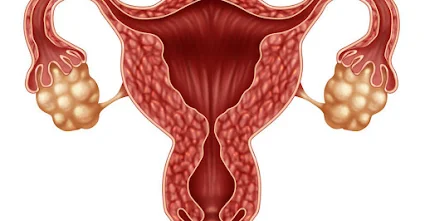What You Need To Know About Ovarian Cysts
Ovarian cysts are fluid-filled sacs that develop within or on the surface of an ovary.
The ovaries are two, small almond-shaped organs located on each side of a woman's uterus that produce eggs and female hormones.
READ ALSO: Uterine Fibroid And Diet: How To Shrink Fibroids Naturally
Types of cysts that can form on the ovaries:
FOLLICULAR CYST
Each month, the ovaries grow tiny follicles (sacs) that hold the eggs. When an egg is mature, the follicle breaks open to release the egg, and then dissolves. If the follicle doesn't break open to release the egg, it forms a follicular cyst.
This type of cyst usually disappears within one to three months.
CORPUS LUTEUM CYST
A corpus luteum cyst occurs after the egg is released from the follicle. The follicle
becomes the corpus luteum. If pregnancy doesn't occur, the corpus luteum normally
breaks down and disappears. If this does not happen and fluid builds up in the corpus
luteum, it can form a cyst. These cysts can grow to almost 10 cm and may cause bleeding or twist the ovary and cause pain. This type of cyst usually goes away on its own after a few weeks.
ALSO: How To Stop Heavy Bleeding And Pain From Fibroids
Other types of cysts include:
Cystadenomas: Cysts that develop from cells on the outer surface of the ovary.
They are often filled with a watery fluid or thick, sticky gel and can become large and painful.
Dermoid cyst: Ovarian cells are able to make hair, teeth, and other tissues. An abnormal growth of these cells can form a cyst. These cysts typically affect younger women.
Endometriomas: A type of cyst that develops in women with endometriosis, a condition where tissue from the lining of the uterus grows outside of the uterus. The tissue may attach to the ovary and form a cyst, which can be painful.
Polycystic ovarian syndrome: Multiple cysts appear on the ovaries due to hormonal imbalance and high insulin levels.
RISK FACTORS
Age: Women of child-bearing age are at greatest risk.
Hormonal imbalances (high estrogen levels)
Also: Health Uses Of Aidan Fruits
SIGNS and SYMPTOMS
Many women have ovarian cysts at some time during their lives and most ovarian cysts are benign (non-cancerous) and disappear without treatment.
However, some cysts can rupture and cause serious symptoms and consequences. For this reason, knowing the signs and symptoms and having regular pelvic exams is important to preserving ovarian health.
Some women have few or no symptoms, while others experience:
- Abdominal fullness or heaviness
- Menstrual irregularities (heavy bleeding or abnormal cycles)
- Nausea, vomiting, or pelvic tenderness
- Pelvic pain that may radiate down the back and thighs
- Ovarian
- Pelvic pain during intercourse
- Pressure on the rectum or bladder
DON'T BE ALARMED
Most ovarian cysts are benign (non-cancerous) and go away within a few months.
If you develop sudden and severe abdominal or pelvic pain along with fever or vomiting, seek immediate medical attention.
TREATMENT
The treatment of ovarian cysts depends on the size and type of cyst, symptoms, and
the woman's age.
- Follicular and corpus luteum cysts are usually just monitored by the doctor and go away on their own.
- Oral contraceptives or progesterone cream are sometimes given to women who get frequent cysts as a way of controlling hormone levels and preventing cyst growth.
- Surgery is usually considered as a last resort for women with malignant cysts, those who have very large cysts that do not go away, and those with severe symptoms or infertility.
FOODS TO AVOID:
- Meat and dairy products may contain saturated fat, hormones, and chemicals that can affect ovarian health and trigger inflammation.
- Minimize caffeine (coffee, tea, chocolate), as it may worsen menstrual irregularities.
LIFESTYLES SUGGESTIONS
Get regular pelvic examinations. Report any unusual symptoms or changes in your menstrual cycle to your doctor.
Reduce stress. Try meditation, breathing exercises, and yoga.
Exercise regularly to reduce stress levels and improve circulation and overall well-being.
Aim for 30 minutes to one hour daily.
READ ALSO: NATURAL REMEDY FOR FIBROID






.jpg)





